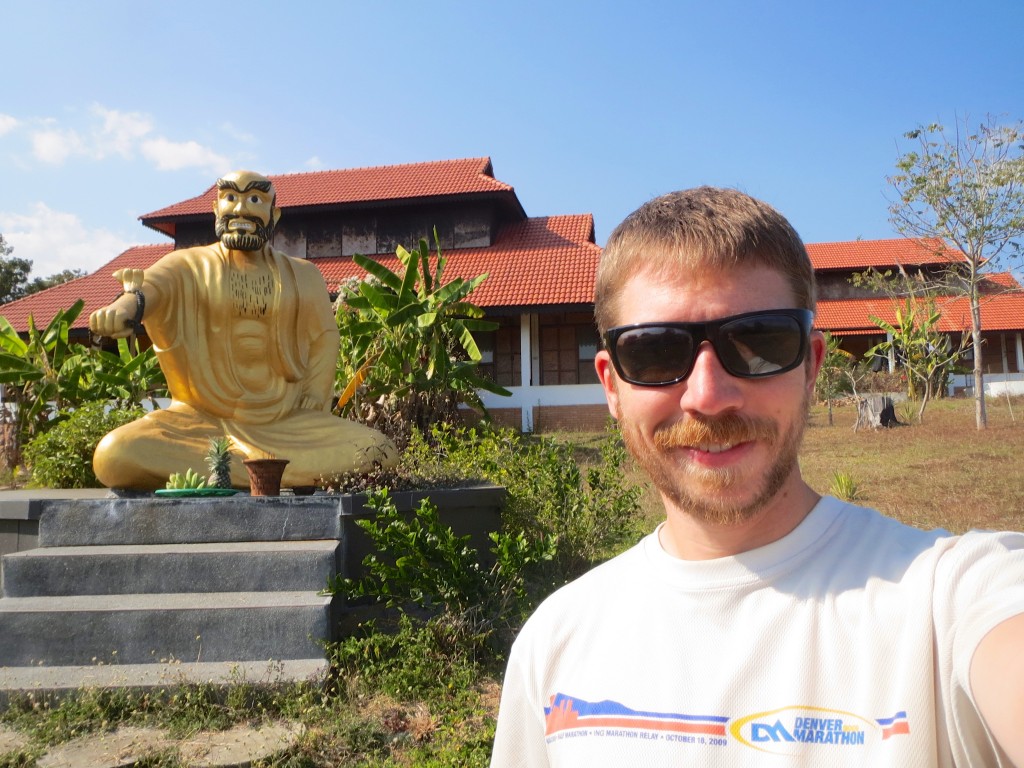Written by Chris
I have just completed my first week of my month-long stay at the Nam Yang Kung Fu Retreat in northern Thailand and I think I have finally settled into the groove. The early mornings take some getting used to as does the daily training after little physical activity over the last month and the simple meals after eating way too much Wendy’s in Kuala Lumpur. Now that I have learned enough to be dangerous (primarily to myself, I think) I would love to share.
I think to most people, kung fu is usually mysterious Chinese monks, awesome action movies, and wise sayings. I quickly learned here that, much beyond those things, it is truly a way of life. The teachings permeate your thoughts and actions and decisions throughout your day and your life. I can easily see how the study can be transformative and why there are those who choose to devote their entire lives to the pursuit of kung fu mastery.
The retreat is run by Master Iain, a British native, 2-time world champion, and lifelong practitioner. He is incredibly down-to-earth and approachable, truly a world-class expert, surprisingly knowledgable of technology and current events, and eager to share his knowledge with is students. It is really astounding how often he drops deep life lessons on us daily. Unfortunately, he just left to attend to the UK branch for a few months, but I will continue to train with his excellent disciples.
To succeed in kung fu requires only 2 things: First, you must start and then, you must keep going
Accommodations are spartan but quite comfortable right at the training facility. We have a dining/kitchen area, a large open training area, and a covered, padded training area. There is a large selection of traditional weapons; most are just for training but a few are very real. There have been anywhere between 5 to 10 students in the time I have been here with some arriving and leaving almost every day. Our daily routine looks like this:
- 6:00am-9:00am – Morning training: Dawn Chi Kung meditation, walking meditation, Shuan Yang Tiger-Crane training, flexibility and tendon strengthening. Tea break in the middle.
- 9:00am – Breakfast: Rice, soup, and vegetables and fruit, much grown on site
- 10:00am-3:30pm – Free time / independent study and practice / tea breaks
- 3:30pm-6:00pm – Afternoon training: Conditioning, more stretching, technique training, practice and drills. Also, tea break.
- 6:00pm – Dinner: Rice, soup, vegetables and fruit…
Additionally, we have 2 rest days per week.
After the first day, I was barely keeping up, exhausted, and very, very sore. I had a lot to learn just in order to be able to participate. But after the first week, I have learned enough to practice a lot on my own and can keep up with the masses. Here’s a brief summary of the things I have been learning:
- Shuan Yang – A slow, meditative rehearsal of the Tiger-Crane forms consisting of 66 steps. I have covered the first 13 so far. They have great names like “The General carrying his seal” and “Pan Gu opens heaven”
- Chi Kung – (or Qigung, Chi Gung) A meditative exercise to balance your inner energy, Chi. I’ve learned the whole sequence and we do this every morning as the sun rises.
- Sum Chien – A 13-step routine that is considered the essence of Shaolin.
- Chin Na – A library of joint-lock techniques for gaining control in a fight. I’ve covered 2 so far.
- Tan Tow, Chinese Broadsword – I started a bit of training on a sword sequence but I think I will let it slide since I can’t imagine a scenario where I would both require a sword and also have one present.
- Staff – I have learned a complete sequence with the 6′ staff that the Shaolin Monks were rumored to have used exclusively to overtake armies in ancient China.
- Stretching – After being a quite inflexible person my whole life, I am already starting to see gains in flexibility with our regular and thorough routines.
- Breathing, meditation, tendon strengthening, and a host of other general lessons
A few things about the training have surprised me. The biggest is that there is very little actual fighting. Kung fu is very effective self defense, but training that part is very advanced. We first learn these series of poses, or forms, (“hungry tiger grasping goat”). Then you practice, practice, practice until your motions are just right. Then one day the instructor grabs your wrist as in a fight situation and says “show me hungry tiger grasping goat” and you do it and it breaks the hold. It is very much Karate Kid (wax the car, paint the fence, sand the floor). Another surprise is that there is very little striking in the art, punches and kicks, as there is so much more emphasis on gaining control of the situation, creating stability, and destabilizing your opponent.
If you are well-trained in kung fu, it is very difficult to get into a fight. Your opponent will usually sense it and back down early on.
Learning kung fu is playing the long game. You’re not going to go out roundhouse kicking people right away. Instead, you build up a rock-solid base and slowly add to it over time to make an incredibly robust philosophy of self-defense. There is much tradition and so much to learn it is hard to choose what to focus on. I hope to get a bit of an overview of the art in my month here. I already feel much fitter, I walk easier and am enjoying the flexibility, and I am heading in the direction of a quieter, more focused mind. I am excited to see what the next few weeks will bring.
There is also no charge for attractiveness:
Skadoosh

Just remember to come back.